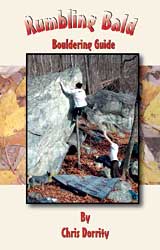When we hear the words “rock climbing,” most of us picture climbers scaling faces of sheer rock, hundreds of feet high. But that’s not always the case. Bouldering is an offshoot of rock climbing, where, as the name implies, a climber scales large boulders instead of rock faces. Over the years it’s grown into a sport in its own right, with climbers seeking out beautiful and difficult pieces of rock to climb.

Boulders generally range from eight to 20 feet tall, though they may be as tall as 50 or 60 feet. Very tall boulders are known as “highballs,” and short ones as “lowballs.” Routes up a boulder are known as “problems.” Many problems follow a line of hand and footholds directly to the top of a boulder. Another popular type of problem is a “traversing problem,” where a boulderer climbs laterally across the boulder, left or right, increasing the amount of endurance required to complete a problem. Other problems may be “link-ups,” or variations of two or more separate problems. Some problems even begin with a “sit-down start,” where the climber begins the problem from ground level, making it longer and often more difficult.
Equipment is minimal. Climbing shoes are made with soles of very sticky rubber, which clings well to footholds. Chalk is used to dry out the hands and improve a boulderer’s grip. A crash pad is a thick, foam-filled mat laid down at the bottom of a problem. When a boulderer falls, he or she will land on the crash-pad with help from the spotter, an assistant who directs the boulderer’s fall toward the pad and away from dangerous objects. One of the sport’s main draws is the freedom of movement it offers. Free from using the normal climbing gear, a boulderer can move more freely over the rock, unhindered by bulk and weight.
Another of bouldering’s draws is the possibility for extreme difficulty that it offers. Bouldering has pushed and continues to push the limit of possibilities on moving over rock. Experienced boulderers tend to seek out problems that push their skills to the limit. Many times it is the unique beauty and difficulty of a particular problem that lures boulderers to attempt it.
Bouldering tends to take place in a very social atmosphere, where friends have a good time trying out problems and spotting each other in turn. A typical day consists of warming up with a few easy and moderate problems, and then trying out personal “projects.” A project is a boulder problem that one wishes to complete but has not been successful at. In order for a boulderer to say that he or she has “climbed” a problem, they must climb it from bottom to top without falling.
Find your boulder
Western North Carolina offers ample bouldering opportunities. Nearest to Asheville is Rumbling Bald, in Chimney Rock, about 40 minutes southeast of town. Rumbling Bald is one of the largest and best places to go bouldering in the state. Other boulder fields near Asheville include North Side Boulders at Looking Glass, near Brevard; Grandmother Boulders in Linville; and Blowing Rock Boulders in Blowing Rock.
Within the southeast region, there are plenty of areas to go bouldering. Many have a distinct style, owing to the specific rock type found there. Grandmother Boulders in Linville are made of quartzite, offering an excellent variety of problems to fit everybody. It’s situated in a pristine high-country setting, surrounded by lush mountains and awesome views.
Boat Rock, in Atlanta, Ga., features smooth granite boulders that are big and round. The style of climbing is very technical and many climbs are vertical face climbs or tall slab climbs. The setting is urban, with views to upscale subdivisions nearby.
Another destination, Horse Pens 40 in Steele, Ala., is a very concentrated boulder-field composed of high-quality sandstone. The style of climbing is technical and requires a lot of power, with many of the problems involving a sloped-out upper portion. The scene is ultra-convenient, with bathrooms, showers, food, and car camping a mere 100 feet from the boulders.
Other boulder fields within driving distance for weekend trips include Little Rock City in Chattanooga, Tenn., and Rock Town in Lafayette, Ga. For information about these and other bouldering areas, go online to the Carolina Climbers Coalition (www.carolinaclimbers.org) or the Southeastern Climbers Coalition (www.seclimbers.org). Also check out local outdoor-retail shops for information and guidance.
Bouldering is a fun sport, and its popularity grows more each year. But with that growth comes the need for an awareness of our environmental impact. Please take care of the rock, plants and animals while visiting these sites, and be a leader in taking care of the environment. Find out some information on these areas and check them out. Once familiar with the sport, get a project, start moving through the difficulty grades and enjoy the great environment among friends in the boulder field.
[Chris Dorrity lives in Arden. He can be reached at chrisdorrity@gmail.com]
Picture yourself there
Chris Dorrity’s new book, Rumbling Bald Bouldering Guide, will be published this fall. The book provides photos, maps, background information and color-coded routes of the popular Chimney Rock bouldering destination. Look for it at local outdoor retailers. For more information, email Chris at chrisdorrity@gmail.com



Nice article!! Good to hear info about sports other than mtn. biking and running. Not that either of those are bad, but Asheville is the best city in the S.E. for its wonderful mountains, trails, rivers and each offer their own recreation.